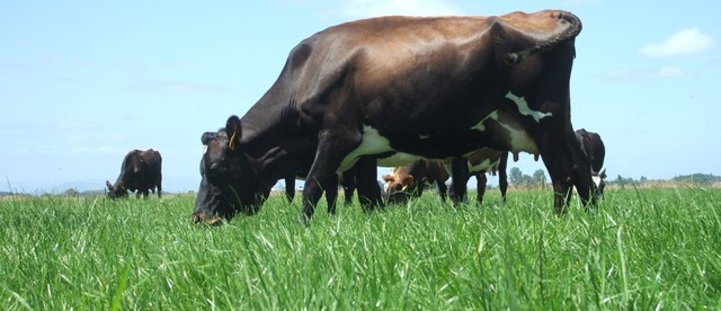Profiting from more home-grown feed in Taranaki
Getting new grass to last and perform on peat soils in Taranaki starts with careful establishment and special attention over the first winter on Robin Rye’s farm east of Eltham.
If all goes to plan, in coming weeks he will again sow approximately 12 hectares (ha) of Trojan perennial ryegrass as part of on-going pasture renewal aimed at improving productivity and reining in feed expenses on 128ha effective (eff) at Rawhitiroa.
Previously, Robin and his contract milkers Quentin and Karla Maindonald have fed up to 460 tonnes of palm kernel (PK) per year.
But now with the low payout that supplement has been cut to reduce costs.
In fact the only thing that stopped them achieving a 60% reduction in PK use last season was Taranaki’s unprecedented facial eczema outbreak in autumn.
Like many in the region, Robin says they’re still paying the price of that outbreak, both in reduced cow numbers and lower milksolids (MS) production.
A total of 365 cows is in milk this season, down from the long term average of 380, and they’re targeting total MS production of 152,000kg. Facial eczema cut 2015/16 production to 143,000kg. At the height of PK supplementation in 2014/15, they reached 171,000kg MS.
Situated at the edge of the Taranaki ring plain, the farm comprises peat swamp flats and volcanic hills, some of which are too steep for tractor work. Annual rainfall is 1500mm. Soil fertility is good. But the combination of contour, peat soils and often wet winter/spring conditions can be hard on pastures.
Robin uses summer turnips to maintain a high level of pasture renewal and introduced Trojan ryegrass five years ago, looking for more DM production on his cultivatable paddocks and also because this variety is backed by plenty of performance data and comes with NEA2 endophyte.
Seed is broadcast onto grazed turnip paddocks once there’s enough moisture in the soil, and following a spray if necessary to control weeds.
After sowing, Robin keeps a close eye on the emerging Trojan and clover and typically sprays again, mainly to eradicate docks.
The aim is to get this herbicide on before the first grazing, which in turn (where possible) is done with weaner heifers before they leave the farm on May 1.
If no weaners are available, cows are used for the first grazing, but with caution. Robin says young Trojan paddocks need to be looked after to ensure strong establishment. So they’re not wintered on but grazed as needed during June and July before coming into the normal grazing round in August.
Subsequent grazing management focuses on maintaining optimal grass performance.
Last autumn, Robin also started using a mix of Trojan and Rohan perennial ryegrass to create a dense, hard wearing pasture which might suit his more difficult hill paddocks.
For more advice on sowing Trojan this autumn please contact your local Barenbrug Area Manager: http://www.Barenbrug.co.nz/contact/Barenbrug-field-team or download a brochure here:


